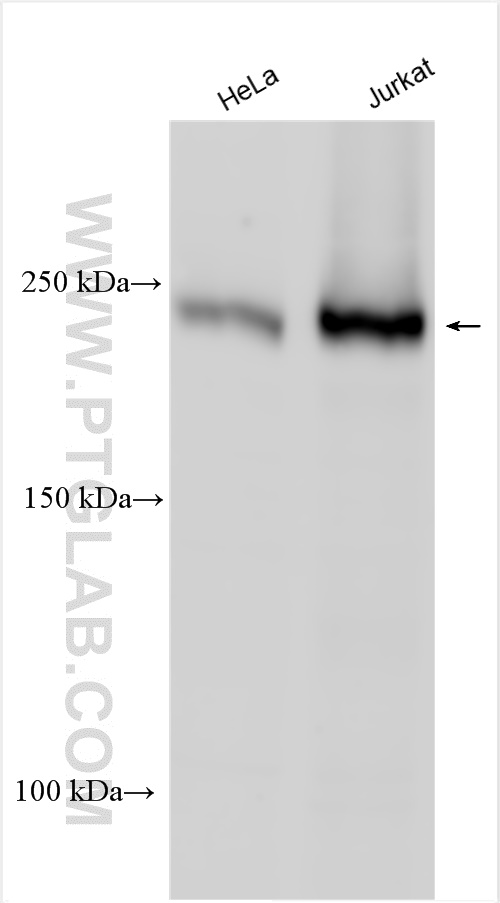验证数据展示
经过测试的应用
| Positive WB detected in | HeLa cells, mouse lung tissue, Jurkat cells, mouse brain tissue, rat brain tissue |
| Positive IHC detected in | human liver cancer tissue Note: suggested antigen retrieval with TE buffer pH 9.0; (*) Alternatively, antigen retrieval may be performed with citrate buffer pH 6.0 |
推荐稀释比
| 应用 | 推荐稀释比 |
|---|---|
| Western Blot (WB) | WB : 1:1000-1:4000 |
| Immunohistochemistry (IHC) | IHC : 1:50-1:500 |
| It is recommended that this reagent should be titrated in each testing system to obtain optimal results. | |
| Sample-dependent, Check data in validation data gallery. | |
发表文章中的应用
| KD/KO | See 1 publications below |
| WB | See 5 publications below |
| IHC | See 2 publications below |
产品信息
13361-1-AP targets PIP5K3 in WB, IHC, Dot Blot, ELISA applications and shows reactivity with human, mouse, rat samples.
| 经测试应用 | WB, IHC, ELISA Application Description |
| 文献引用应用 | WB, IHC, Dot Blot |
| 经测试反应性 | human, mouse, rat |
| 文献引用反应性 | human, mouse, pig, sheep |
| 免疫原 | PIP5K3 fusion protein Ag4177 种属同源性预测 |
| 宿主/亚型 | Rabbit / IgG |
| 抗体类别 | Polyclonal |
| 产品类型 | Antibody |
| 全称 | phosphatidylinositol-3-phosphate/phosphatidylinositol 5-kinase, type III |
| 别名 | CFD, FAB1, KIAA0981, PIKFYVE, PIP5K, PIP5K3, PIPkin III, Type III PIP kinase |
| 计算分子量 | 451 aa, 50 kDa, 237 kDa |
| 观测分子量 | 237 kDa |
| GenBank蛋白编号 | BC032389 |
| 基因名称 | PIP5K3 |
| Gene ID (NCBI) | 200576 |
| RRID | AB_10638310 |
| 偶联类型 | Unconjugated |
| 形式 | Liquid |
| 纯化方式 | Antigen affinity purification |
| UNIPROT ID | Q9Y2I7 |
| 储存缓冲液 | PBS with 0.02% sodium azide and 50% glycerol , pH 7.3 |
| 储存条件 | Store at -20°C. Stable for one year after shipment. Aliquoting is unnecessary for -20oC storage. |
背景介绍
PIP5K3 (1-phosphatidylinositol 3-phosphate 5-kinase), also callled PIKFYVE, belongs to a large family of lipid kinases that alter the phosphorylation status of intracellular phosphatidylinositol (PMID: 15902656; 9858586). The content of phosphatidylinositol 3,5-bisphosphate (PtdIns(3,5)P2) in endosomal membranes changes dynamically with fission and fusion events that generate or absorb intracellular transport vesicles. PIKFYVE is the PtdIns(3,5)P2-producing component of a trimolecular complex that tightly regulates the level of PtdIns(3,5)P2. Other components of this complex are the PIKFYVE activator VAC14 and the PtdIns(3,5)P2 phosphatase FIG4 (PMID: 17556371). In addition to its phosphoinositide 5-kinase activity, PIKFYVE also has protein kinase activity (PubMed: 11714711; 17556371).PIP5K3 has four isoforms with molecular weights of 237 kDa, 50 kDa, 51 kDa and 62 kDa. This antibody primarily recognizes the 237 kDa isoform.
实验方案
| Product Specific Protocols | |
|---|---|
| WB protocol for PIP5K3 antibody 13361-1-AP | Download protocol |
| IHC protocol for PIP5K3 antibody 13361-1-AP | Download protocol |
| Standard Protocols | |
|---|---|
| Click here to view our Standard Protocols |
发表文章
| Species | Application | Title |
|---|---|---|
Mol Cell TSC1 binding to lysosomal PIPs is required for TSC complex translocation and mTORC1 regulation.
| ||
Elife Lipid kinases VPS34 and PIKfyve coordinate a phosphoinositide cascade to regulate retriever-mediated recycling on endosomes. | ||
PLoS Pathog Pseudorabies virus inhibits progesterone-induced inactivation of TRPML1 to facilitate viral entry | ||
Front Oncol TRIM68, PIKFYVE, and DYNLL2: The Possible Novel Autophagy- and Immunity-Associated Gene Biomarkers for Osteosarcoma Prognosis. | ||
Animals (Basel) Prolactin Inhibition Promotes Follicle Recruitment by Increasing PIKfyve Expression in Ewes During the Estrus Stage | ||
Eur J Pharmacol Inhibition of c-Rel DNA binding is critical for the anti-inflammatory effects of novel PIKfyve inhibitor. |





